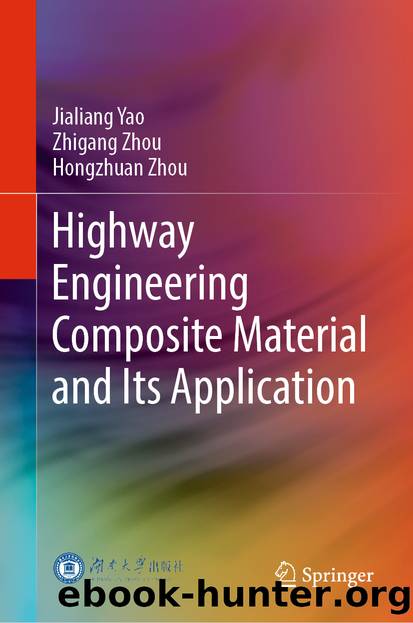Highway Engineering Composite Material and Its Application by Jialiang Yao & Zhigang Zhou & Hongzhuan Zhou

Author:Jialiang Yao & Zhigang Zhou & Hongzhuan Zhou
Language: eng
Format: epub
ISBN: 9789811360688
Publisher: Springer Singapore
Segregation Test
As the polymer is segregated from the asphalt in the process of stopping mixing, cooling, and storage, the polymer-modified asphalt cannot be used immediately after producing. It needs to cool, store, transport, and reuse after heating. The segregation test of modified asphalt is carried out to evaluate the compatibility of modifier with the matrix asphalt.
The polymer-modified asphalts such as SBR and SBS float when segregating. The test is to inject asphalt in the test tube and the specimen height is 180 mm. The specimen is then put in oven for 48 ± 1 h at 163 ± 5 ℃. is removed and put in the refrigerator for 1 h later. The modified asphalt condenses into a solid and then is pulled out. It is cut into the same three parts. The softening point of top and bottom specimens is measured, respectively. The difference of their softening points indicates the degree of segregation.
The polymer-modified asphalts, such as PE and EVA, adsorb the four sides of the container wall when segregating. Because of the surface crusts, the segregation test is to pour the asphalt into the specimen cup at the high temperature. Then, put it into oven for 15–18 h at 135 ℃ and observe the surface. At the same time, slowly detect the specimen with a small scraper, and check the consistency of surface layer and the sediment of the bottom, as shown in Table 4.1.Table 4.1Test evaluation of PE and EVA
Download
This site does not store any files on its server. We only index and link to content provided by other sites. Please contact the content providers to delete copyright contents if any and email us, we'll remove relevant links or contents immediately.
| Concrete | Extraction & Processing |
| Fracture Mechanics | Materials Science |
| Metallurgy | Polymers & Textiles |
| Strength of Materials | Testing |
Whiskies Galore by Ian Buxton(40331)
Introduction to Aircraft Design (Cambridge Aerospace Series) by John P. Fielding(32338)
Small Unmanned Fixed-wing Aircraft Design by Andrew J. Keane Andras Sobester James P. Scanlan & András Sóbester & James P. Scanlan(32141)
Craft Beer for the Homebrewer by Michael Agnew(17446)
Turbulence by E. J. Noyes(7039)
The Complete Stick Figure Physics Tutorials by Allen Sarah(6638)
Kaplan MCAT General Chemistry Review by Kaplan(6053)
The Thirst by Nesbo Jo(5785)
Bad Blood by John Carreyrou(5769)
Learning SQL by Alan Beaulieu(5411)
Weapons of Math Destruction by Cathy O'Neil(5036)
Man-made Catastrophes and Risk Information Concealment by Dmitry Chernov & Didier Sornette(4735)
iGen by Jean M. Twenge(4702)
Digital Minimalism by Cal Newport;(4540)
Life 3.0: Being Human in the Age of Artificial Intelligence by Tegmark Max(4507)
Audition by Ryu Murakami(4099)
1,001 ASVAB Practice Questions For Dummies by Powers Rod(4038)
Electronic Devices & Circuits by Jacob Millman & Christos C. Halkias(4027)
Pale Blue Dot by Carl Sagan(4001)
